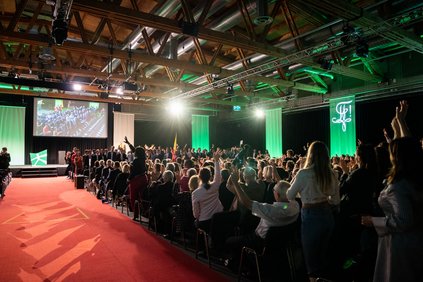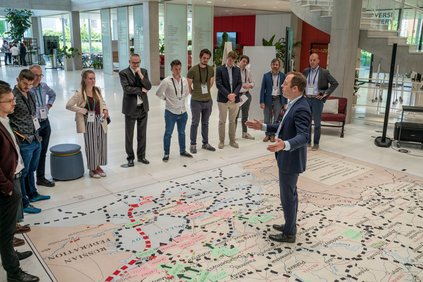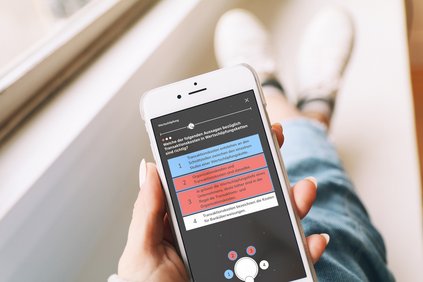Campus - 08.04.2020 - 00:00
Innovative teaching formats: didactic transfer
Teaching is constantly being reformed, as is the training of aspiring teachers. The Business Education programme has accepted this challenge and is demonstrating a pattern of innovative teaching and learning. By student reporter Thomas Tarantini.

8 April 2020. Blended learning – a fashionable term in didactics. There is a reason for this: a combination of online and offline activities evidently boosts the learning process in comparison with traditional forms of teaching. The University of St.Gallen has not failed to notice this, and accordingly, various courses are cultivating and adapting this principle.
The four-part course series on “Didactic Transfer” constitutes the centrepiece of the Business Education programme at the University of St.Gallen. According to lecturer Eric Tarantini, a Ph.D. student at the Institute of Business Education and Educational Management (IWP-HSG), blended learning is also gaining ground at academic-stream secondary schools and vocational colleges: “Teaching at this level is increasingly characterised by teachers’ role change towards a form of supervision or coaching, while pupils are making increasing use of individual learning blocks. This perspective is also important when it comes to teacher training.”
Focus on the video medium
In Didactic Transfer I (Bachelor’s Level) and II (Master’s Level), students develop fundamental teaching competencies, which is why it is particularly important to train them with modern methods and media. For this purpose, an innovative course in social video learning was staged in Autumn Semester 2019 – in real time. What does this mean? In the course, aspiring teachers conducted two mini-teaching blocks (microteachings) of 20 minutes’ duration each. The subjects to be taught were Business Administration, Economics, Law and Accountancy. In his pilot group, Eric Tarantini recorded these microteachings with his smartphone. In parallel, fellow students used an app to input marks with regard to assessment criteria that had previously been allocated to them. These included the teacher’s behaviour, the use of media, as well as verbal and non-verbal communication. In classic editions in other groups, video notation also takes place, but without a live function.
In a next step, students translated their marks into informative comments through their laptops. The video recordings and the comments were interlinked in so-called annotations through the edubreakCAMPUS platform, i.e. once the video recording was complete, it was uploaded to the platform, and all the students’ inputs, including the relevant points in time, were automatically integrated. The upload time was so short that oral feedback could even be provided in the same teaching block. This is why the course was run in two blocks of four lessons each – two for microteachings and comment notations, and two for the corresponding feedback discussions.
Effective memorisation
The video material with the integrated situation-specific feedback was subsequently used for the aspiring teachers’ reflection of their own teaching practice. This enabled students of business education to acquire more depth. In this connection, Eric Tarantini emphasises the importance of the dual-track processing of information through image and text and remarks that this demonstrably leads to a better memorisation of the teaching contents – a reason why social video learning is a particularly effective teaching and learning method.
Owing to the corona crisis, the course design had to be converted to purely digital in Spring Semester 2020. As in numerous other courses, the Zoom platform proved a great help. This has changed the setting considerably: a teaching situation in a classroom becomes a webinar. “For this reason, the microteachings are not graded this semester, only the lesson plans and reflection reports are,” explains Eric Tarantini. This solely applies to the current edition of the seminar. Complete online conversion substantially hampers the development of relationships and emphatic cooperation. After the current exceptional situation, courses will return to the design used in the preceding semester.
First emotional, then rational
“Digital elements always serve to provide support. People and interaction with other people remain centre stage. When it comes to skills like empathy, individual comprehension and the development of relationships, people are likely to remain ahead of technology forever,” says Eric Tarantini. Ideally, digital tools should improve students’ learning objective attainment. Their use is always directly linked to the question of benefit, and this will not change with the introduction and exploration of new technologies relevant to teaching, such as robotics, artificial intelligence and virtual reality. “Emotionality prevails over rationality. Before something can enter the head, the heart must be won.”
Thomas Tarantini is studying Business Innovation (MBI) and attending the Business Journalism programme.
Photo: Eric Tarantini, recording of a microteaching with real-time comment column.
More articles from the same category
This could also be of interest to you
Discover our special topics
















